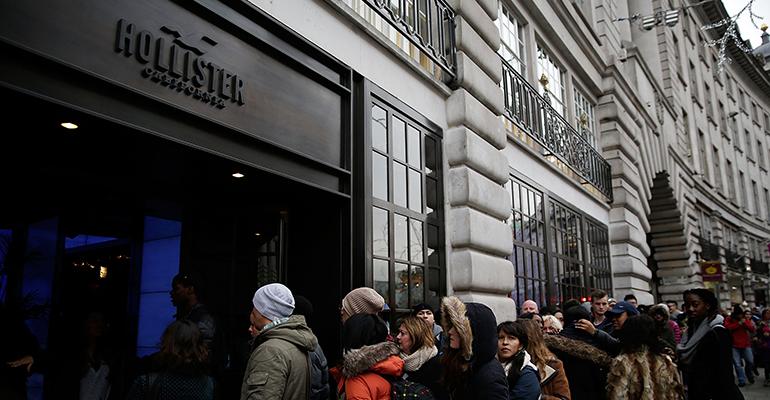(Bloomberg)—After years of being relegated to the back of the closet, Hollister has been reborn.
Though the heyday of the seagull logo is long past, the teen apparel brand with the California vibe has charged back into the mix, trying to turn things around for its struggling parent, Abercrombie & Fitch Co. The bird was once a stamp of approval for cool kids—until it wasn’t, and sales tanked. The broader demise of logo apparel didn’t help.
The Hollister of today isn’t the same, Abercrombie CEO Fran Horowitz said in a phone interview Thursday. She repositioned the brand as a cheerful, carefree version of its former elitist self—logos are mostly out, fashion tops and denim are in.
“We have very much evolved from what was a very specific thought of a beach brand,” said Horowitz.
The numbers are encouraging: Hollister reported its third straight quarter of positive comparative store sales Thursday, up 5 percent from the same period the year prior. Wall Street is optimistic, too, with market watchers saying the business is stabilizing.
Hollister has made “real, sustainable progress,” Randal Konik, an analyst at Jefferies LLC, wrote in a note to clients. Various moves, such as the remodeling of stores, a new loyalty program, and merchandising decisions are making a tangible impact in the brand’s performance, he wrote. Cheaper clothes, like a pair of jeans for $25, don’t hurt, either.
Paul Lejuez, an analyst at Citigroup Inc., agreed. Though it may not be as cool as it used to be, he said, Hollister is now “very relevant—and we believe relevant brands will survive in this environment.”
In the late 2000s, Hollister ruled teen retail, even surpassing its more mature sister brand Abercrombie. High schools across America were covered in the Hollister seagull. By 2011, sales spiked past $2 billion.
Back then, Hollister didn’t advertise much—it didn’t need to. Foot traffic in malls was higher, its brand cachet was stronger, and unique stores attracted browsers, Horowitz said. Dressed up like a beach shack complete with a front porch and tiled roof jutting out into mall corridors, kids who were susceptible to the California ideal couldn’t help themselves. Lifeguard models and logo polos rounded out the conceit of casual, West Coast cool.
“That was all about presentation,” said Horowitz. “There was no customer engagement.” Then came the fall. Between 2012 and 2016, sales cratered by 20 percent.
Now, Hollister stores are noticeably different. Gone are the signature cabanas with dark-hued interiors. The stores are brighter, the music lighter, and even the mannequins are more approachable. The racks are easier to navigate, with an open layout so employees can focus on customer interaction. Last year, the company remodeled 65 stores and will complete 40 more in 2017. The new format is more productive, but Hollister remains far from completing its transformation, given that it has 542 stores worldwide.
The brand is emphasizing fashion over billboarding, but de-emphasizing the logo brings risks—it’s already impossible to tell if some shirts or dresses came from H&M , Zara, or Forever 21. That means Hollister must stay on-trend. Right now, the focus is on destroyed denim, which the label considers a top fashion item at the moment. Hollister’s jeans business hit record highs this past quarter, the company said.
But as uncool as human branding has become, the once inescapable Hollister logo won’t vanish entirely. Horowitz made clear that it will always have a place in the company’s business.
To contact the authors of this story: Kim Bhasin in New York at [email protected] Lindsey Rupp in New York at [email protected] To contact the editor responsible for this story: David Rovella at [email protected]
COPYRIGHT
© 2017 Bloomberg L.P

